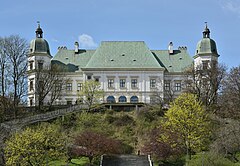Ujazdów Castle
| Ujazdów Castle Zamek Ujazdowski | |
|---|---|
 Ujazdów Castle, seen from the Royal Canal | |
 | |
| General information | |
| Architectural style | Baroque-Neoclassical |
| Town or city | Warsaw |
| Country | Poland |
| Coordinates | 52°13′10.16″N 21°01′51.92″E / 52.2194889°N 21.0310889°E |
| Completed | 1624, 1974 |
| Demolished | 1944 |
| Client | Sigismund III Vasa |
Historic Monument of Poland | |
| Designated | 1994-09-08 |
| Part of | Warsaw – historic city center with the Royal Route and Wilanów |
| Reference no. | M.P. 1994 nr 50 poz. 423[1] |
Ujazdów Castle (
Its beginnings date to the 13th century, and it was rebuilt several times. Like many structures in Warsaw, it sustained much damage in the Warsaw Uprising (1944). Reconstructed 30 years later (1974), it now houses Warsaw's Center for Contemporary Art.
History
The first castle on the spot was erected by the Dukes of
The ruins of the castle of the Mazovian princes were then incorporated into a new fortified manor built by King
Again neglected, in 1674 the castle was bought by
The castle's design was further modified by King

Consequently, between 1784 and 1789 the castle was yet again rebuilt, this time by

After the fall of the uprising, the Russian garrison of Warsaw was significantly strengthened, while the Polish military units were disbanded. A new central military hospital was built next to what became the
After Poland regained her independence in 1918, the internal design of the castle was yet again modified. Since the 1920s it housed several parts of the Warsaw NCO school. The main staircase was restored to its 18th-century representative design. An interesting feature of the staircase was a set of stone tablets placed there May 15, 1927, commemorating the names of all known Polish military medics who perished in wars between 1797 and 1920.
After the war, the building was to be rebuilt as the Central Military House. However, the works did not start as the walls of the castle were demolished by the Communist authorities of Poland in 1954.[5] In 1975, however, the works on reconstruction of the castle to its 18th-century design were given a green light, and the project by Piotr Biegański was chosen.[2] It houses Warsaw's Center for Contemporary Art (Centrum Sztuki Współczesnej) since 1985.[6]
Centre for Contemporary Art

The castle houses the Centre for Contemporary Art, with its collections and temporary exhibitions, concerts and educational workshops.[6] The Centre has organized over 600 exhibitions since 1990.[6] From 2010 to 2016, the Centre's director was an Italian, Fabio Cavallucci.[7]
In 2017, Piotr Bernatowicz was appointed director by the Polish culture minister
Ujazdów Castle has exhibited numerous well known artists:
- Magdalena Abakanowicz
- Paweł Althamer
- Eric Andersen
- Janusz Bałdyga
- Mirosław Bałka
- Wojciech Bąkowski
- Krzysztof Bednarski
- Jerzy Bereś
- Christian Boltanski
- Włodzimierz Borowski
- George Brecht
- Wojciech Bruszewski
- Tomasz Ciecierski
- Matt Collishaw
- Atilla Csorgo
- Zbigniew Dłubak
- Andrzej Dłużniewski
- Stanisław Dróżdż
- Edward Dwurnik
- Stefan Gierowski
- Zbigniew Gostomski
- Maurycy Gomulicki
- Katarzyna Górna
- Izabella Gustowska
- Lynn Hershman
- Jenny Holzer
- IRWIN
- Zuzanna Janin
- Piotr Jaros
- Zdzisław Jurkiewicz
- Koji Kamoji
- Ilya Kabakov
- Jerzy Kałucki
- Marek Kijewski
- Joseph Kosuth
- Piotr Kowalski
- Jarosław Kozłowski
- Katarzyna Kozyra
- Edward Krasiński
- Barbara Kruger
- Zofia Kulik
- Oleg Kulik
- Paweł Kwiek
- Natalia LL
- Dominik Lejman
- Norman Leto
- Zbigniew Libera
- Richard Long
- Hanna Łuczak
- Marcin Maciejowski
- Robert Maciejuk
- Jarosław Modzelewski
- Teresa Murak
- David Nash
- Roman Opałka
- Tony Oursler
- Dennis Oppenheim
- Michelangelo Pistoletto
- Wojciech Prażmowski
- Mariola Przyjemska
- Karol Radziszewski
- Joanna Rajkowska
- Józef Robakowski
- Ursula von Rydingsvard
- Wilhelm Sasnal
- Mikołaj Smoczyński
- Marek Sobczyk
- Daniel Spoerri
- Henryk Stażewski
- Andrzej Szewczyk
- Leon Tarasewicz
- Tomasz Vetulani
- Aleksandra Waliszewska
- Zbigniew Warpechowski
- Lawrence Weiner
- Emmet Williams
- Ryszard Winiarski
- Krzysztof Wodiczko
- Krzysztof Zarębski
- Artur Żmijewski
- Vasiliy Ryabchenko
Gallery
-
Ujazdów Castle
-
Entrance to Castle
-
Marble lion from Ujazdów Castle by anonymous Italian sculptor, 1630s, Drottningholm Palace
-
Piaseczyński Canal seen from Myśliwiecka Street
-
View of Royal Canal from Castle terraces
-
Castle tower
See also
- Jan Kochanowski
- Royal Castle, Warsaw
- Castles in Poland
Notes
- ^ Zarządzenie Prezydenta Rzeczypospolitej Polskiej z dnia 8 września 1994 r. w sprawie uznania za pomnik historii., M.P. z 1994 r. Nr 50, poz. 423
- ^ a b c d e f g h i j k l m n o p q r s t "Zamek Ujazdowski". www.warszawa1939.pl (in Polish). Archived from the original on 2012-02-04. Retrieved 2009-03-22.
- ^ ISBN 83-01-03323-1.)
{{cite book}}: CS1 maint: location missing publisher (link - ^ a b Marcin Latka. "Marble lions from the Ujazdów Castle". Retrieved 9 September 2018.
- ^ "History of Ujazdowski Castle – Ujazdowski Castle Centre for Contemporary Art".
- ^ a b c "Centrum Sztuki Współczesnej Zamek Ujazdowski | Miejsce".
- ^ "Centrum Sztuki Współczesnej Zamek Ujazdowski". Csw.art.pl. 2010-09-22. Retrieved 2012-11-02.
- ^ Marshall, Alex (January 8, 2020). "A Polish Museum Turns to the Right, and Artists Turn Away". The New York Times. Retrieved January 23, 2020.
References
- Centre for Contemporary Art
- (in Polish) Zamek ujazdowski at warszawa1939.pl



![Marble lion from Ujazdów Castle by anonymous Italian scul-tor, 1630s, Drottningholm Palace[4]](http://upload.wikimedia.org/wikipedia/commons/thumb/2/2a/Drottningholm_Lejon_entre_01.JPG/80px-Drottningholm_Lejon_entre_01.JPG)





